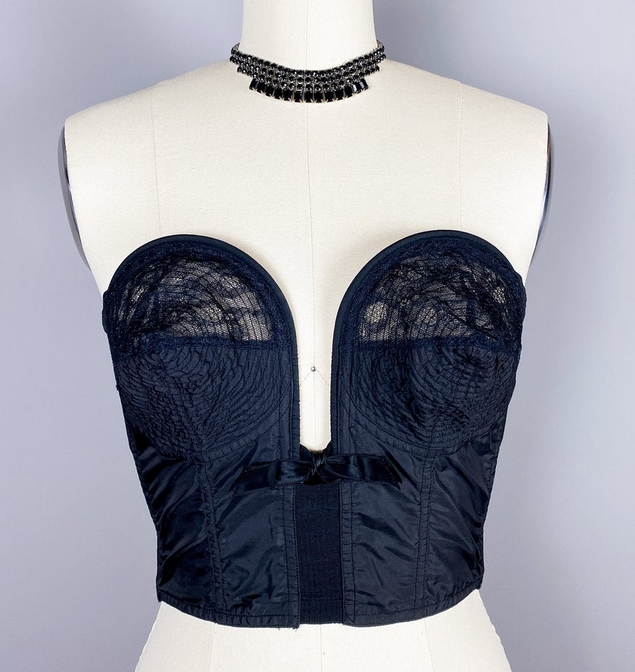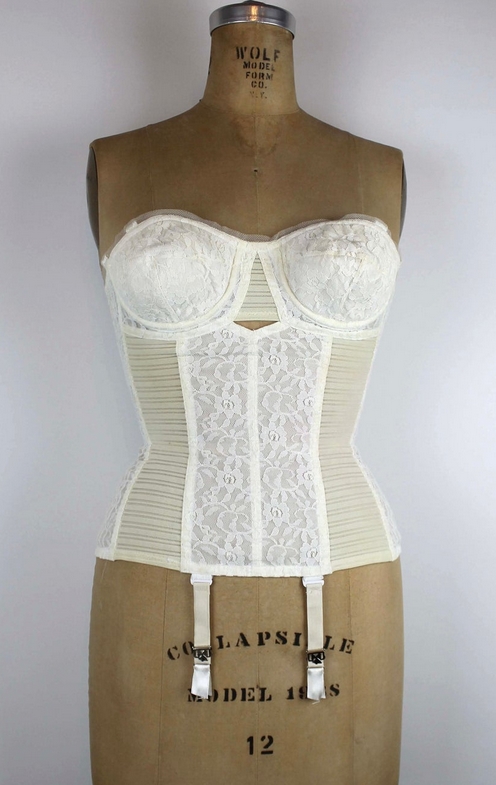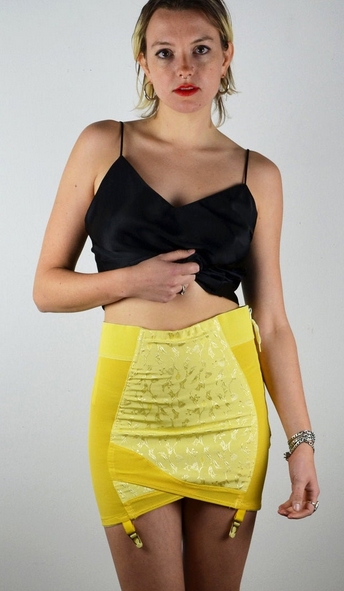Disclosure: This post may contain affiliate links. I receive a small commission at no cost to you when you make a purchase using my link.
1950s lingerie styles and trends were heavily influenced by the glamour and va-va-voom of the era’s most influential Hollywood stars. Marylin Monroe, Jane Russell, and Lana Turner had glowing confidence which was partly expressed in the comfort of their own curves.
In the 50s we start to see women showing off their shape instead of trying to pin it down. This is reflected in 1950s lingerie styles and trends. The skirts were getting puffier and the undergarments were becoming glamorized and of equal importance to post-war consumers who thought they’d have to stitch the same bra year after year to make it last. Big changes were made to the bra while other undergarments began the metamorphosis to stronger material, comfortable shapewear, and more variety across the board.
1950s Bra

In the process of easing women out of the war-time restrictions, the bra became a symbol of bold beauty. This included the large cone-shaped stitched bra and the high-rounded bosom with padded cups.
Strapless, longline, and bullet bras describe only a small variety of 1950s bras and bralettes. This is the widest range women in the west have ever seen. Nylon and cushion fabric were also introduced. In the 1950s a bigger bust was the desired look if only to match wide hips. It was truly the era that popularized the coke bottle, curvy figure. The sweater girl bra didn’t last but remains iconic to the era.
Though new materials were introduced, 1950s bras were made primarily of nylon, rayon, or cotton. For added fashion, some bras included floral print, trim, lace, stitching, or bows. Most unique to its time were long-line bras which were primarily strapless and had boning that stretch down the torso to slim the diaphragm area and add lifting support.
Ranging from 98 cents to three dollars, design, stitching, fabric, and wearability played an important role to consumers. With greater options came greater expectations in the bra’s durability and design.
Falsies became popular as a way to add volume and lift to the bust. The falsie wasn’t yet refined so it would absorb moisture, odor, and fall apart easily. But they were still a more common accessory than most women of the time would care to admit. These softening cups were contrary to the era’s bullet bra which was the opposite of round soft and was instead pointed and quite firm. Later in the decade, all sorts of “bust improvers” became available and their popularity soared.
1950s Underwear

Referred to as panties, 1950s underwear didn’t undergo the same evolution that the 1950s bra did. They remained high-waisted with an elastic waist. They were made of cotton knit, rayon, or satin; though perhaps slightly more fitted than the bloomers of the previous era.
There were more fitted “granny panties” to remove the need for sanitary belts. For more youthful sizes, floral and other prints were an option. Otherwise, the most variation to be seen was lace trim, embroidery, or ruffles at the bottom of briefs. The color palette remained neutral with white, nudes, and pastels. Fitted underwear was worn with fitted clothes otherwise the loose-brief style was suitable for the era of full circle swing skirts.
1950s Corset

Nylon taffeta and nylon marquisette were just making their debut in the late ’40s. In the following decade, these materials began to glamorize corsetry and undergarments in general. For most women, corsets were critical for creating the favored shape in the fifties. However, comfort was not compromised. Previous generations suffered pretty intense discomfort to achieve the desired figure. But these post-war women wanted the best of both worlds.
Stiff steel boning was replaced with plastic and zippers making the 1950s corset easier to get in and out of. The full corset covered the entire torso and included an attached bra with straps. Full corsets would stop at the waist or just below. Soon, the 2-way stretch corset was introduced. This had to be essentially rolled on and focused on full-body shaping.
The 1950s corselet isn’t far from where we are today with the modern corselet. It cinches the waist, flattens the tummy, and lifts the bust. The strapless corselet was named after the vintage movie Merry Widow and is still referred to by the same name. 1950s corsets and corselets often included girdles to hold underwear in place.
The “waspie” was another popular 1950s corset. It simply wrapped around the waist to tighten it and accentuate the space between hips and waist. It didn’t include a bra or any straps. It was tight and rigid but served its shaping purposes precisely. For those who didn’t naturally possess the desired shape, the waspie would be paired with a long-line brassiere and hip padding for the desired hourglass look. However, the popularity was short-lived as it was replaced by an elasticated cotton roll-on girdle with suspenders attached.
1950s Girdles, Garter Belts, & Petticoats

1950s girdles were perhaps more popular than the 1950s corset. They were the recommended undergarment to suit the cut of women’s dress pants and skirts. The panty girdle from the ’50s is still used in modern girdle designs. This legged girdle has stood the test of time because of its functionality. Unlike the layer sarong girdle, the panty girdle is easier to sit, stand, and walk in.
Both girdles were meant to cinch in what the other garments may have let spill out. As the top layer, the girdle also refined and smoothed the shape. Girdles were also on the frontier of 1950s lingerie styles and trends as they explored many patterns, colors, and designs. Something other garments simply weren’t. Girdles were extremely fitted and it was recommended to put talcum powder all over to allow it to slip on, especially in hotter weather.
Garter belts were used to hold up stalkings and hadn’t yet been coined as glamorous or sexy. Half slips and full slips hadn’t evolved much, though the material was now made from firmer cotton and kept dresses and skirt suits from clinging. Petticoats were usually rayon, cotton, or taffeta and decorated with lace, bows, and other detailing.
Conclusion
Memorable and distinct, 1950s lingerie style and trends remain iconic and are usually what we think of when we think vintage lingerie.
Head over to Etsy to browse the selection of 1950s vintage and vintage-inspired lingerie.




Leave a Reply